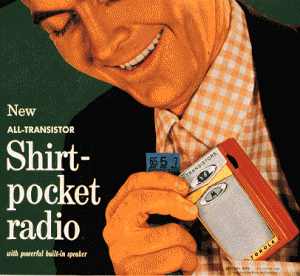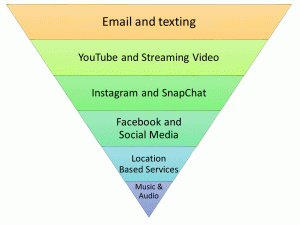SARA portends to disrupt the world’s current understanding of and consumption of radio and mobile audio. The universally standard system that serves what will be interactive radio will also generate a host of beneficiaries. In targeting the most pervasive handset technology on the planet to reach all peoples, SARA will drive considerably more traffic to cellular networks and introduce opportunities to dramatically increase wireless revenues for all carriers and content providers.

Radio isn’t Portable
Consider radio. People listen longer. Their consumption is not transactional; it is driven by desirable content pushed to a largely passive audience satisfied to delegate to a broadcaster the active involvement with selecting audio. Now consider this: radio is not portable. That’s right. Radio is trapped in our cars; radio is built into our home theaters and our bedside alarm clocks. But even though radio waves are all around us, radio is not portable. Radio hasn’t been portable since the beginning of this century when it became clear that there’s only room in our pockets for one device. Nobody carries a transistor radio. Everybody carries a phone. And those phones can go everywhere radio goes as well as everywhere radio cannot.
Over the past twenty years radio broadcasters have lost a major share of audience. They don’t realize this because weekly tune-in to AM/FM is still enormous. But this vast listenership might listen even more to radio if it was truly as portable as cell phones. After all, most audio is consumed on-the-go.
This puts carriers in a position to leapfrog broadcast radio. Their networks are completely cohesive; every radio listener also has a cell phone so a wireless audience is already out there and proven. And carriers can deliver the killer app: interactivity. Carrier network traffic has historically been transmissions of brief one-to-one exchanges of information – voice calls. Much of this traffic now moves in the form of lower cost texts and email, and carriers increasingly rely on data subscriptions to drive revenue. The cohesive voice infrastructure goes under-monetized and unnoticed as a platform ripe for infotainment-centric audio content delivery, a platform for Radio 2.0.
Telephones today are no longer mere conduits for two-way conversation. With cognitive computing, interactivity enables the delivery of personalized audio streaming that rivals what smartphone apps deliver. Interactivity also enables instant purchasing and transacting with advertising and content. All on a platform as pervasive as radio, and with a national, not localized, presence. Moving radio consumption to carrier networks drives traffic, extended usage, and creates access to transactional and other new income streams. Carriers can dramatically increase wireless revenues while revolutionizing radio and mobile audio streaming for a one-to-one relationship with each subscriber/listener.

Mobile Data User’s Hierarchy of Needs
Mobile audio apps don’t generate incremental income to carriers. Mobile audio apps compete with social, games and video on what is not a level playing field – and they are losing the competition for consumer interest. That’s the insurmountable dilemma for any app maker contending with the consumption-limiting mobile data user’s hierarchy of needs. But what seems like a dire situation actually teaches the path for carriers to increase wireless revenues and ARPU while simultaneously casting a survival lifeline to audio providers. Adoption of the voice line to deliver mobile audio content dramatically increases usage of underutilized cohesive infrastructure and presents opportunities to monetize that consumption and increase wireless revenues with an interactive location-aware service superior to today’s radio.
The most successful and entrenched platform for mobile audio remains radio. Compatible devices are pervasive and radio network infrastructure nearly as so, though regionally fragmented. Not television or home-based Internet coverage rivals the reach and universal adoption of radio. But wireless telephony does. And the cohesive infrastructure that supports wireless telephony also enables seamless national coverage and reach of a radio alternative.
Radio is still massively successful because of fundamental factors that any audio provider would be wise to emulate, but most importantly, radio is pervasive, standardized, universal and simple to use – just like telephones. Today’s generation of mobile audio apps are none of these things.
Wouldn’t the most logical platform for mobile consumer audio be the one with a device penetration that rivals radio and requires no learning curve to adoption and use? Wireless carriers have already built-out the cohesive networks that combined exceed terrestrial radio’s coverage while enhancing service with distinctive features including interactivity and personalization. Carriers can dramatically increase wireless revenues by monetizing their already built-out networks as conduit for mobile audio.
 Diverting audio consumption to the voice line creates an access point to interactive audio for subscribers using feature phones or smartphones on metered service or without data plans – essentially doubling-to-tripling the immediate prospective audience available to discover mobile streaming audio for the first time. Instead of mobile audio being relegated to a small segment of smartphone users, it can be immediately accessible to anybody with a phone.
Diverting audio consumption to the voice line creates an access point to interactive audio for subscribers using feature phones or smartphones on metered service or without data plans – essentially doubling-to-tripling the immediate prospective audience available to discover mobile streaming audio for the first time. Instead of mobile audio being relegated to a small segment of smartphone users, it can be immediately accessible to anybody with a phone.
Carriers don’t need to compete with radio or audio streaming services to reap financial rewards. Carrier networks can be leveraged to extend the reach of current providers and enable enhanced services through interactivity. That was the original intention of the current generation of apps from the likes of SiriusXM and iHeartRadio.

Click to view our brochure
The mobile telephone is a two-way radio. It transmits as well as receives, which makes it an interactive device, which terrestrial radio is not. The technology of SaraConnects is designed to instantly transform any telephone into a smart, personalized interactive radio. Access requires only a dialed telephone call or text. No apps, no data, no gigs, no restrictions. Sara’s artificial intelligence is optimized for audio and voice and is designed for rapid deployment. We actively seek carrier partners and audio content providers to exploit this opportunity; join us: https://saraconnects.world/contact
#saraconx #interactiveradio #frictionless #saraconnects






